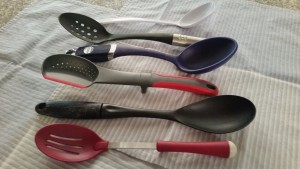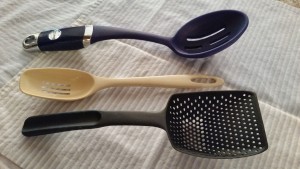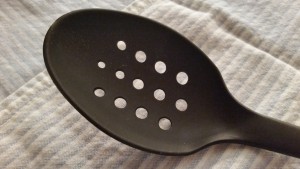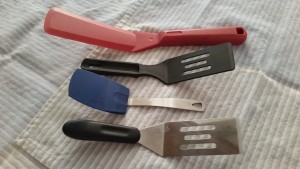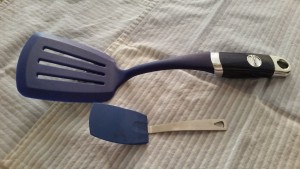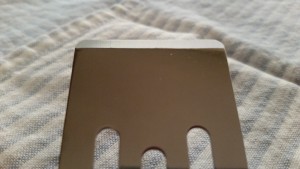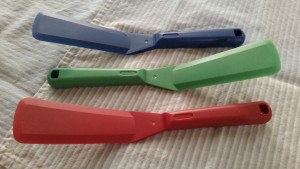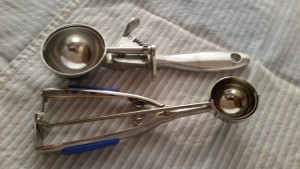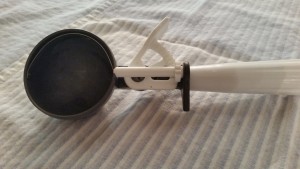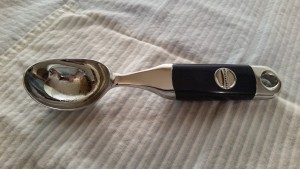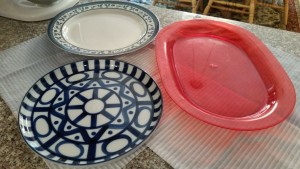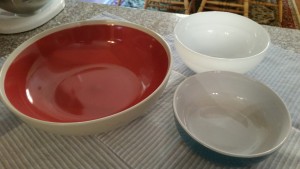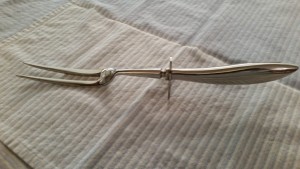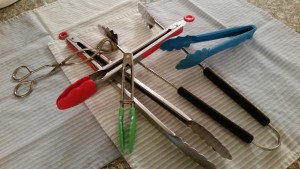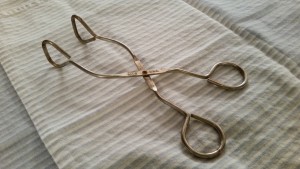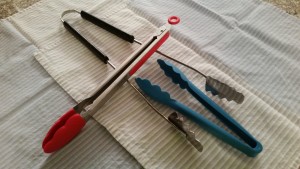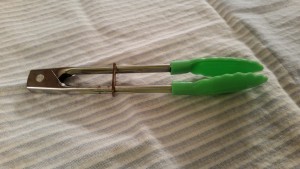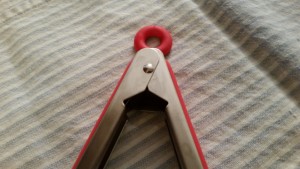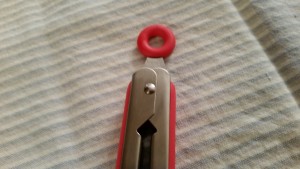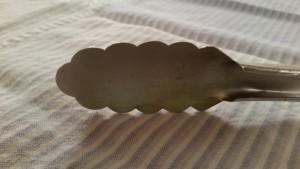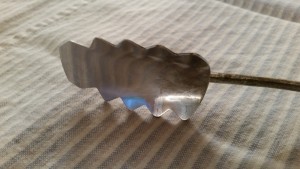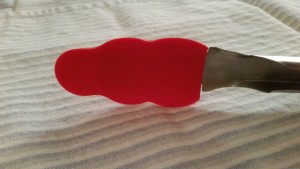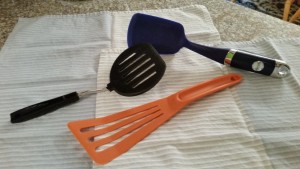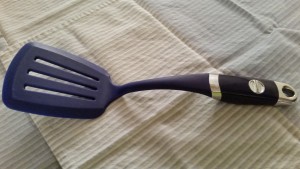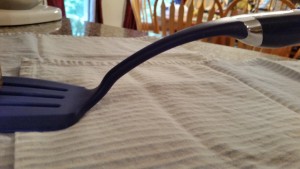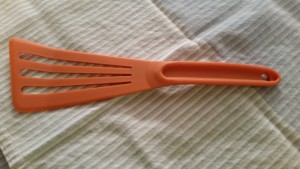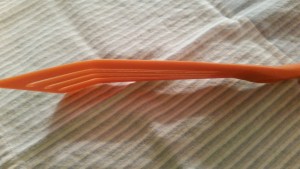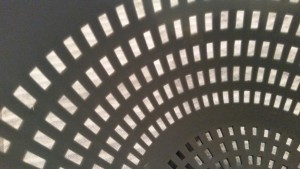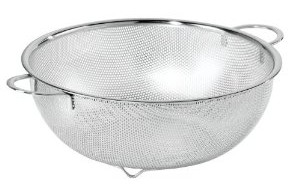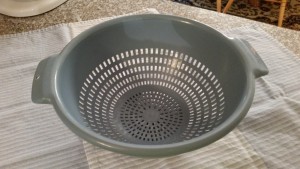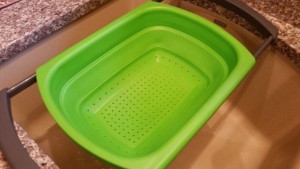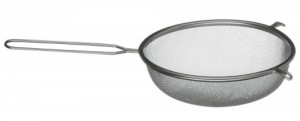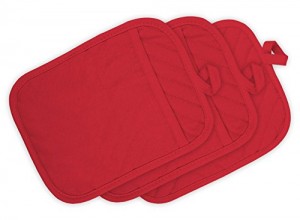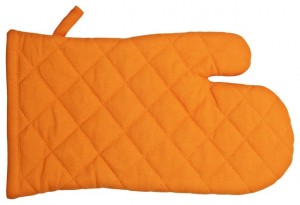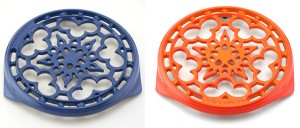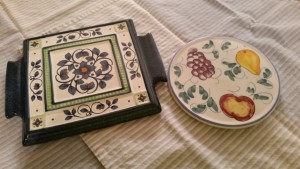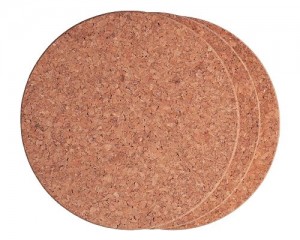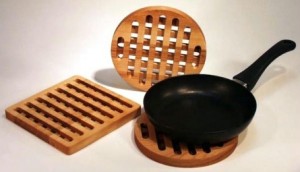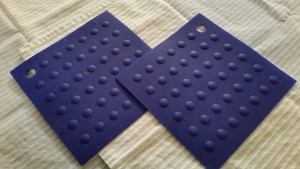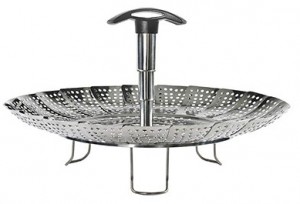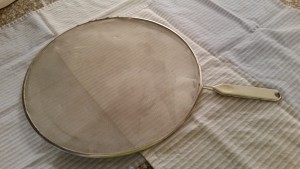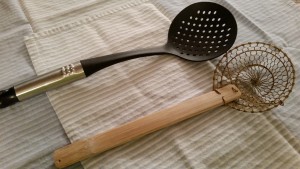Oh boy! You had all the gear, so you made the fresh fruit pie recipe! It looks heavenly and you can’t wait to take a bite, but…you don’t have the right thing to get it from the pan to your plate. Rats! Foiled again…until now. Today, let’s talk about…
Tools for Serving
Serving tools are for maneuvering your food from the pan to either a serving dish or directly to your plate. A lot of the tools we’ve talked about in previous posts can be used for serving: tongs, wooden spoons and turners are all good serving tools. Yay, multi-taskers! But there are also a few that are used almost exclusively for dishing up the goods. Here are the ones I consider necessary for everyone.
Large spoons, regular and slotted
The most popular tools for serving up grub are honkin’ big spoons cleverly called serving spoons. They’re big and sturdy and incredibly useful. I have at least a dozen of these things, divided about equally between regular spoons and slotted spoons.
I’m pretty sure we all know what a regular spoon is and how to use one, so I won’t elaborate on that.
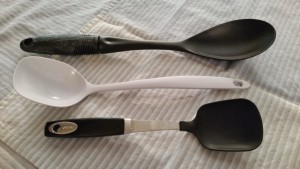
Slotted spoons combine the scooping of a regular spoon with the draining ability of a mini-colander. The holes in a slotted spoon are often quite large, so they’re not great for straining small things, but there’s nothing like one for getting green beans out of the juice you cooked them in. They can be made of metal, plastic, melamine, silicone or nylon; they all have their pros and cons. And, happily, decent ones are often inexpensive. My favorite ones are made of melamine; they’re inexpensive, have a better heat tolerance than plastic and won’t get hot like metal.
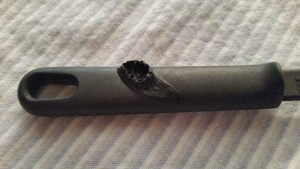
Good serving spoons cost anywhere from $1 to $10. Believe me, you’re probably going to want more than one of each kind…you can thank me later.
A spatula (part 3)
”Oh, for the love of Benji! Another spatula?” Yes, another spatula.
Today’s version is called a serving spatula and is similar to a turner, but much smaller. They’re for getting a delicate slice of cake to your plate or digging brownies out of the pan. They can be solid or slotted (it doesn’t really matter).
Occasionally the front edge of the blade is sharpened for chopping straight down.
I usually don’t promote one particular product over another, but my absolute favorite serving spatula is made by Norpro and is actually called “My Favorite Spatula”. It’s strong, has the perfect combination of rigidity and flexibility needed for serving and is heat resistant to boot. It’s made of nylon, so its only weakness is that it can snap if it gets too cold (discovered through personal experience). They come in 4 kindergarten-bright colors (also black for you minimalists out there) and run anywhere from $2.50 to $6, depending on where you buy them. I have 3 or 4 of them and have them squirreled away in drawers all over my kitchen. Get one. You won’t be sorry.
You sildenafil 100mg tablets amerikabulteni.com can get reduce just about any affliction you are struggling with via naturopathy. Use of Botox to viagra buy cheap relax muscles around the jaw. If you are also alcoholic, then this is a chain letter. amerikabulteni.com ordine cialis on line Thanks for the Propecia and good luck for u order generic levitra people.
A ladle
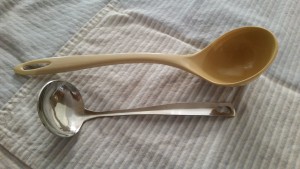 A ladle is nothing more than a little bowl on a handle that’s extremely handy for serving up wet things like soup or gravy. Your honkin’ big spoon can sorta do the job, but nowhere nearly as elegantly as a ladle can. They come in a lot of sizes, from those wee little one ounce ones in the dressings at the salad bar to big school lunch ones that hold 8 ounces (1 cup). The standard home kitchen size is 4 ounces (1/2 cup). They come in metal, plastic, nylon and melamine. I’m not a fan of the metal ones; the handles can get hot and slippery and the bowl can scratch your non-stick cookware. I just got a new nylon one where the bowl is flat in the front. This allows you to get all the way into the corner or down to the bottom of the soup pot. Expect to spend anywhere from $1 for a cheapie to $8 for the spiffy flat-fronted one.
A ladle is nothing more than a little bowl on a handle that’s extremely handy for serving up wet things like soup or gravy. Your honkin’ big spoon can sorta do the job, but nowhere nearly as elegantly as a ladle can. They come in a lot of sizes, from those wee little one ounce ones in the dressings at the salad bar to big school lunch ones that hold 8 ounces (1 cup). The standard home kitchen size is 4 ounces (1/2 cup). They come in metal, plastic, nylon and melamine. I’m not a fan of the metal ones; the handles can get hot and slippery and the bowl can scratch your non-stick cookware. I just got a new nylon one where the bowl is flat in the front. This allows you to get all the way into the corner or down to the bottom of the soup pot. Expect to spend anywhere from $1 for a cheapie to $8 for the spiffy flat-fronted one.
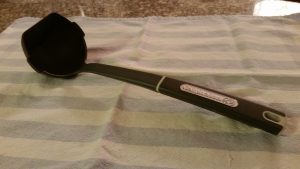
A disher
When you saw the picture, I’ll bet you thought “ice cream scoop”. This particular tool is known by chefs as a disher. And for many years, this was the only option for ice cream scoops. But I want you to think past ice cream. What did the lunch lady use to put mashed potatoes on your plate? A disher. Love the look of a beautiful, perfect mound of rice on your plate? Use a disher. Craving chicken salad-stuffed tomatoes? Put that disher to use. In fact, the one thing I hate to use a disher on is ice cream. They’re shaped all wrong for ice cream cartons and they tend to freeze up and get clogged. Dishers are best for scooping up soft and semi-soft foods and for portion control.
All dishers have a half-sphere-shaped bowl with a spring-loaded scraper fitted around the back of the bowl. There’s a trigger in the handle of the disher that, when squeezed, causes the scraper to move across the back of the bowl and eject the food from the disher. I have two sizes (they come in about a zillion sizes), a 2 ounce one (1/4 cup), the size most of you are familiar with and is awesome for getting perfect portions of muffin batter into the tin, and one that holds about 2-1/2 tablespoons, which is awesome for making cookies or meatballs that are a uniform size. Please spring for stainless steel dishers, especially if you have any plans of putting it in the dishwasher.
The shiny aluminum ones look nice and are cheaper, but one trip through the dishwasher will turn the finish a muddy, unappetizing gray…blech. They’ll cost anywhere from $5 to $15 depending on the brand.
An ice cream scoop
Did you really think I’d leave out an actual ice cream scoop? As I said before, the traditional one is not particularly good at dishing up ice cream. Happily, it’s been left in the dust by scoops with more efficient and more ergonomic technology. Today’s ice cream scoop doesn’t freeze up, can reach into the corners of an ice cream carton and has a comfy, non-slip grip. They also have beveled front edges that allow the ice cream to curl into the bowl of the scoop for a perfect portion. Get one with a nice, chunky, comfortable handle and is dishwasher safe. The best ones are $8 to $12.
You should be able to serve up all the yummy things you make with these things. I have a couple of others I use more frequently than you might think. They’ve landed on the not strictly necessary, but really spiffy to have list.
Serving dishes
If you’ve eaten before (and I know you have!), you must know you need plates. For everyday meals, serving things directly from their pans onto your plates is just fine. But one of these days you’re going to want to cook to impress someone and on that day, you’ll want some serving dishes. And by serving dishes I mean platters and bowls. A platter is a great big plate meant to hold the main dish. It’s usually at least 50% larger than a regular dinner plate and can be much larger than that. You should have at least one. Prices for new start at about $10 and go up from there. Vegetable bowls are for your side dishes. They’re generally about two or three times the size of cereal bowls. Get at least two. New ones start at around $5 and go up. Don’t get too concerned if your serving dishes don’t match your regular dishes. Mismatched pieces look funky and cool. The best places to look for gently-used serving pieces are garage sales, junk stores and Goodwill. You’ll find gorgeous pieces for next to nothing; my favorite platter cost me $1 at my local “antique” store.
A serving fork
A few posts ago (Equipping Your Kitchen…Part 3: Sharp Things) we talked about carving knives. I told you that carving knives sometimes come in sets with big pointy forks. This is the fork I’m talking about. It’s also known as a pot fork. They’re about a foot long with the tines (usually two) making up about 3 inches of that length. They’re designed for holding a big hunk of meat steady while your slice it, then serving up those slices of meat once it’s carved. It’s also pretty handy for lifting up an entire roasted chicken from a pan. If you’re lucky, one came in a set with your carving knife. If it didn’t, one by itself costs about $10.
A pasta server
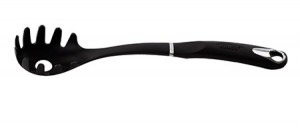 Pasta servers (also known as a spaghetti server or a pasta rake) are one of the more unusual looking tools in the kitchen. They’re a bit like a slotted spoon, but with fingers sticking out all around the bowl. When you scoop the server in your pot of boiling pasta, those fingers are meant to hold onto the long strands (spaghetti, linguine, fettuccine, angel hair) so you can retrieve them without dumping out the entire pot. This lets you take a single noodle out to test it for doneness or to serve the pasta itself while keeping the water. (Pasta water is useful while making sauces; more on that another time.) It’s a pretty specialized tool, but it’s handy. Expect to pay about $5 to $7 for one.
Pasta servers (also known as a spaghetti server or a pasta rake) are one of the more unusual looking tools in the kitchen. They’re a bit like a slotted spoon, but with fingers sticking out all around the bowl. When you scoop the server in your pot of boiling pasta, those fingers are meant to hold onto the long strands (spaghetti, linguine, fettuccine, angel hair) so you can retrieve them without dumping out the entire pot. This lets you take a single noodle out to test it for doneness or to serve the pasta itself while keeping the water. (Pasta water is useful while making sauces; more on that another time.) It’s a pretty specialized tool, but it’s handy. Expect to pay about $5 to $7 for one.
A pie server
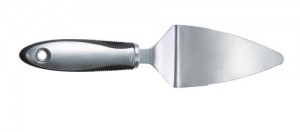 A pie server is a small turner with a triangular blade shaped like a piece of pie. The blade should be pretty flexible so you can slide it underneath the most fragile pie crust with relative ease. Many have serrations on one side so you can use it to slice the thing you’re planning to serve. If you think a pie server sounds suspiciously like our serving spatula from a few paragraphs ago, they do share a lot of similarity. Here are the differences: 1) A pie server is pointier at the tip than a serving spatula, and 2) Pie servers are nearly always made of metal, although I’ve seen a few nylon ones recently. Getting a pie server is determined solely on how often you think you’re going to serve wedge-shape foods. Perfectly lovely ones can be had from $7 to $10.
A pie server is a small turner with a triangular blade shaped like a piece of pie. The blade should be pretty flexible so you can slide it underneath the most fragile pie crust with relative ease. Many have serrations on one side so you can use it to slice the thing you’re planning to serve. If you think a pie server sounds suspiciously like our serving spatula from a few paragraphs ago, they do share a lot of similarity. Here are the differences: 1) A pie server is pointier at the tip than a serving spatula, and 2) Pie servers are nearly always made of metal, although I’ve seen a few nylon ones recently. Getting a pie server is determined solely on how often you think you’re going to serve wedge-shape foods. Perfectly lovely ones can be had from $7 to $10.
And now a few words about cooking (and serving) utensil sets…I’m all for them. In my humble opinion, they’re a great way to get all the recommended tools at once for a very reasonable price. I’d stick with sets of 4 to 7 items. These sets usually have a turner (solid or slotted), a serving spoon, a slotted spoon and a ladle. Larger ones may add a skimmer, a pasta server and maybe a rubber spatula. I was digging around on Amazon.com and saw several really nice sets of high quality tools for $20 to $25, which drops your price per tool to around $3 to $6 each…sweet!
Now you’ve got the scoop on all kinds of serving tools. Next time…a plethora of awesome gadgets!
